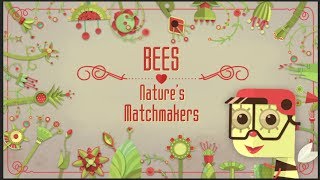(单词翻译:单击)
Bees are very busy little matchmakers. Wingmen in every sense of the word.
小小蜜蜂是非常忙碌的红娘,在这世界的每一个角落牵线搭桥。
You see, the bees' side of the whole 'birds and the bees' business is to help plants find mates and reproduce.
你看,蜜蜂在整个“小鸟和蜜蜂”事件中的作用,就是帮助植物寻到伴侣并进行繁衍。
In their work as pollinators, honeybees are integral to the production of nearly 1/3 of the food that we eat.
作为授粉昆虫,我们所吃食物的近三分之一都离不开蜜蜂对生产的帮助。
And these bees, dutifully helping lonely plants have sex, aren't alone.
并且,这些尽职尽责地帮助孤独植物寻找伴侣的蜜蜂们并不是独自在战斗的。
But rather are part of a very complex network of matchmaking creatures,
它们是一个复杂的“红娘网”中的一部分,
critical for the pollination of natural ecosystems and crops.
对生态体系和作物的授粉起着至关重要的作用。
Plants in many natural ecosystems need help to have sex.
在很多自然生态系统中,植物都需要帮助才能繁殖。
Like many of us, they're too busy to find a relationship.
就像我们中的很多人一样,它们忙得没空去寻找伴侣。
They have too much photosynthesis to do,
它们有太多的光合作用要进行,
and they can't find the time to evolve feet and walk to a singles bar.
并且它们没有时间去进化出双脚,也不能“走”到酒吧。
Those places are called meat markets for a reason, because plants can't walk.
酒吧被称作“‘肉类’市场”是有原因的,因为植物是不能走路的。
So they need matchmaker pollinators to transport their pollen grains to flowers of the same plant species,
所以它们需要传粉者牵线搭桥,把它们的花粉粒传播给同种植物的花朵,
and they pay these pollinators with food.
与此同时,它们也给传粉者提供食物。
Today, around 170,000 plant species receive pollination services from more than 200,000 pollinator species.
今天,大约有17万种植物都在使用传粉服务,也有超过20万种的传粉者。
Pollinators include many species of bees, butterflies, moths, flies, wasps, beetles, even birds and bats,
传粉者包括很多种蜜蜂、蝴蝶、蛾子、苍蝇、胡蜂、甲虫,甚至还有鸟类和蝙蝠,
who together help pollinate many species of trees, shrubs and other flowering plants.
它们齐心协力,帮助了许多种树木、灌木和其他开花植物传粉。
In return, flowering plants are an abundant and diverse food source for pollinators.
作为回报,开花植物给传粉者提供大量丰富的食物来源。
For instance, fossil records suggest bees may have evolved from wasps that gave up hunting after they acquired a taste for nectar.
比如,化石记录显示,蜜蜂可能是从某些因尝试过花蜜后而放弃猎食的胡蜂进化而来的。
Plant pollinator networks are everywhere.
植物和传粉者的互动无处不在。
Ecologists record these networks in the field by observing which pollinators visit which plants,
生态学家们实地考察并记录植物和传粉者的关系网,观察哪种传粉者会拜访哪种植物,
or by analyzing the identity of pollen loads on their bodies.
或分析传粉者身上花粉的种类。
Networks, registered in these ways, contain from 20 to 800 species.
这样的一个关系网,可以包含从20到800种物种。
These networks show a repeated structure, or architecture.
这些关系网体现出了一个重复性的框架结构,或可称为艺术建筑。
Pollinators interact with plants in a very heterogenous way.
传粉者以很不均匀的方式和植物们接触。
Most plants are specialists, they have only one or a few matchmakers.
大多数植物都是狭生性物种,它们只有一种或者很少的红娘。

Meanwhile, only a few generalist plants hire a diverse team of matchmakers,
同时,另外不多的一些植物是广生性的,雇佣了一队形形色色的红娘,
getting visits from almost all the pollinators of the network.
并接受关系网中几乎全部传粉者的拜访。
The same occurs with pollinators.
同样的情况也发生在传粉者身上。
Most are specialists that feed on only a few plant species, while a few pollinators, including the honeybee usually,
大多数狭生性物种都只去很少的植物那儿觅食,但一少部分传粉者,包括最常见的蜜蜂,
are generalists, busily feeding from and matchmaking for almost all the plant species in that ecosystem.
都是广生性物种,忙碌地为生态系统中的几乎全部植物找对象,也接受几乎所有植物提供的食物。
What's interesting is that specialists and generalists across both plants and pollinators, sort themselves out in a particular pattern.
值得一提的是,植物和传粉者中的狭生性物种和广生性物种都以一种特定的形式将自己和大众区分开来。
Most pollinator networks, for which we have data, are nested.
我们的数据显示,大多数传粉者关系网都是嵌套的。
In a nested network, specialists tend to interact more with generalists than with other specialists.
在一个嵌套的关系网中,狭生性物种更倾向于与广生性物种交往,更甚于与其他狭生性物种交往。
This is because if you're a specialist plant,
这是因为如果你是一棵狭生性植物,
and your only matchmaker also specializes on you as its only food source, you're each more vulnerable to extinction.
并且你唯一的传粉者也把你当作它唯一的食物来源,那么你们在物种灭绝的压力下都会更脆弱。
So, you're better off specializing on a generalist pollinator that has other sources of food to ensure its persistence in bad years.
所以,作为一棵狭生性植物,你唯一的传粉者如果还能有别的食物来源,这样更能保证它在灾年的存活,对你自身传粉也更有益处。
The same goes if you're a specialist pollinator.
同样的道理也适用于一个狭生性传粉者。
You're better off in the long run specializing on a generalist plant
以长远计,你最好专攻一种广生性的植物,
that gets pollinated by other species in times when you're not around to help.
这样当你不在附近帮忙时还能从其他种类身上授粉。
Finally, in addition to nestedness, the networks are usually modular.
最后,除了嵌套性之外,这些关系网通常都是模块化的。
This means that the species in a network are compartmentalized into modules of plants and animals
这意味着,在关系网中的物种,同一模块中的动物和植物
that interact more with each other than with species in other modules.
会进行更多的互动,而不常与其他模块的物种互动。
Think of them like social cliques.
可以把这些模块想象成社会中排外的小团体。
A plant or pollinator dying off will effect the species in its module,
某个植物或传粉者的死亡会更多地影响它这个模块中的物种,
but those effects will be less severe on the rest of the network. Why's all that important?
但对关系网中的其他物种,它的影响就没有那么严重了。那么,关系网到底为什么如此重要呢?
Because plant pollinator network structure effects the stability of ecosystems.
因为植物和传粉者之间的关系网结构会影响到整个自然生态系统的稳定性。
Heterogeneous distribution, nestedness and modularity enable networks to better prevent and respond to extinctions.
非均匀分布、嵌套性和模块化,使关系网能够更好地预防和应对物种灭绝。
That's critical because nature is never static. Some species may not show up every year.
这点至关重要的,因为自然从来不是一成不变。有些物种可能不一定每年都会出现。
Plants flower at different times. Pollinators mature on varying schedules.
植物在不同的时间段开花,传粉者也有各种各样成长阶段。
Generalist pollinators have to adapt their preferences depending on who's flowering when.
广生性传粉者要根据不同植物的开花时间调整它们对食物的喜好。
So from one flowering season to the next, the participants and patterns of matchmaking can drastically change.
所以从一个花期到另一个,传粉的参与者和形式都可以发生翻天覆地的变化。
With all those variables, you can understand the importance of generalist pollinators,
有这么多的变数,你就能了解广生性传粉者的重要性,
like bees, to the stability of not only a crop harvest,
比如蜜蜂,它们不但对作物收成的稳定性很重要,
but the entire network of plants and pollinators we see in nature, and rely on for life.
对我们在大自然中随处可见的整个植物及传粉者的网络也很重要,而且还靠它们维持生命。
Next time you see a bee fly by,
下次,当你见到一只蜜蜂飞过时,
remember that it belongs to a complex network of matchmakers critical to the love lives of plants all around you.
要记得它属于一个复杂的传粉者关系网,并对你周围所有可爱的植物有着至关重要的影响。


